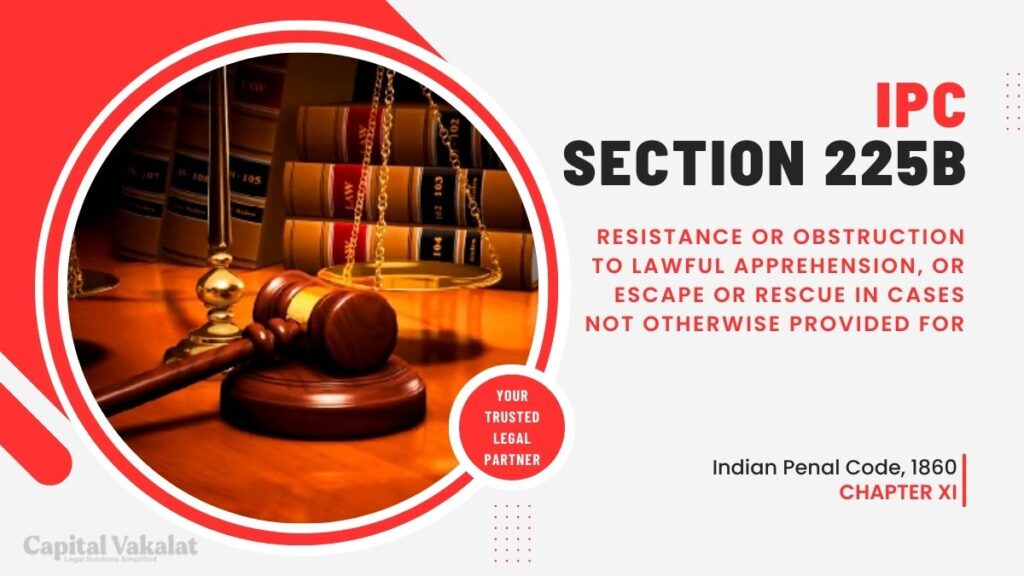In a society governed by laws, justice and order are paramount. The Indian Penal Code (IPC) plays a pivotal role in upholding these principles, and one of its lesser-known sections, Section 225B, deals with “Resistance or Obstruction to Lawful Apprehension, or Escape or Rescue in Cases Not Otherwise Provided For.”

This article aims to shed light on the intricacies of this section, its significance in contemporary society, and its role in ensuring justice is served.
Introduction to Section 225B IPC
Section 225B IPC is a part of the Indian Penal Code, which was first drafted in 1860. It addresses situations where individuals resist or obstruct lawful apprehension or attempt to escape or rescue someone from legal custody. This section is often overshadowed by its more prominent counterparts but remains a critical component of the Indian legal framework.
Understanding the Legal Framework
Before delving into the specifics of Section 225B, it’s crucial to understand the broader legal framework within which it operates. The IPC is a comprehensive legal document that outlines various offenses and their corresponding punishments. It provides the necessary guidelines for maintaining law and order in society.
What Constitutes Resistance or Obstruction to Lawful Apprehension?
Defining the key elements: To understand Section 225B better, let’s break down its two primary components: resistance or obstruction to lawful apprehension. Resistance can manifest in various forms, including physical resistance, verbal threats, or attempts to evade arrest. Obstruction, on the other hand, encompasses actions that hinder or prevent the lawful apprehension of an individual.
Real-life examples: To illustrate this, consider a scenario where a person resists arrest by using physical force, or a group of individuals obstructs a police officer from carrying out a lawful arrest. These actions fall under the purview of Section 225B IPC and may result in legal consequences.
Escape or Rescue: A Legal Perspective
When does escape or rescue come into play? Section 225B also addresses situations where individuals attempt to escape from lawful custody or rescue someone from it. Escape refers to any act or attempt to evade legal custody, such as breaking out of prison. Rescue pertains to efforts made to liberate someone who is legally detained, even if the detainee is willing to be rescued.
Case studies: Examining past cases helps clarify the practical application of this section. Instances where prisoners have attempted to escape or accomplices have tried to rescue them provide valuable insights into the legal complexities surrounding Section 225B IPC.
The Role of Section 225B IPC in Upholding Justice
Section 225B plays a crucial role in ensuring that the due process of law is followed. It prevents individuals from avoiding legal consequences or thwarting the execution of lawful apprehension. By addressing resistance, obstruction, escape, and rescue, this section contributes to maintaining order and justice within society.
Challenges in Enforcing Section 225B IPC
While Section 225B is essential, it is not without its challenges. Identifying and proving resistance, obstruction, escape, or rescue can be complicated. Law enforcement often faces hurdles in collecting evidence and establishing the guilt of the accused, making the enforcement of this section a complex task.
Penalties and Consequences
Understanding the gravity of the offense is vital in appreciating the significance of Section 225B IPC. Depending on the severity of the offense and other factors, penalties can vary from fines to imprisonment. These consequences serve as a deterrent against actions covered by the section.
Significance in Contemporary Society
In modern times, Section 225B IPC remains relevant in various situations. Whether it’s dealing with individuals trying to evade arrest, rescuing someone from legal custody, or preventing obstruction in the process of apprehension, this section continues to play a critical role in upholding justice and order.
Case Analysis: Landmark Judgments
A thorough analysis of this section would be incomplete without examining some landmark judgments that have shaped its interpretation and application. These cases provide insights into the evolution of Section 225B and its implications in different contexts.
Conclusion: Upholding the Law and Justice
In conclusion, Section 225B IPC serves as a vital component of the Indian legal system. It addresses issues related to resistance or obstruction to lawful apprehension, as well as escape or rescue. In a world where maintaining law and order is essential, this section ensures that justice prevails. Despite its challenges, Section 225B remains a beacon of hope for justice and upholding the rule of law.
Frequently Asked Questions
Can an individual be charged under Section 225B for resisting arrest even if they are innocent?
Section 225B applies to situations where lawful apprehension is obstructed or resisted. If an individual believes they are wrongly accused, they should address the issue through legal channels rather than resorting to resistance.
Are there any exceptions or defenses for actions covered by Section 225B?
Defenses or exceptions may vary depending on the specific circumstances of the case. It’s essential to consult legal counsel for advice tailored to a particular situation.
Is Section 225B IPC only applicable to individuals, or can organizations be charged under it as well?
Section 225B IPC primarily deals with individuals’ actions. However, if an organization is involved in actions covered by the section, it may face legal consequences through its responsible individuals.
How has the interpretation of Section 225B evolved over time, and what significant changes have occurred?
The interpretation of Section 225B has evolved through landmark judgments, legislative amendments, and changes in societal norms. To understand the specific developments, one would need to study case law and legal literature.